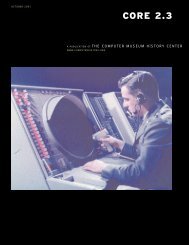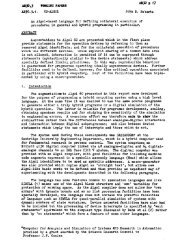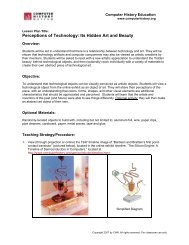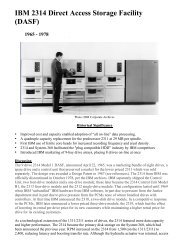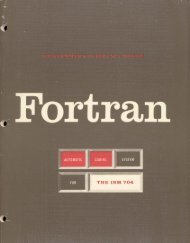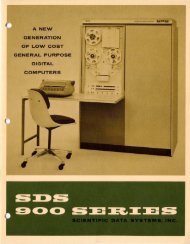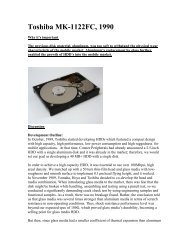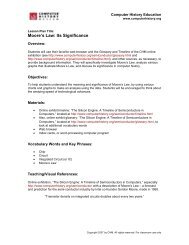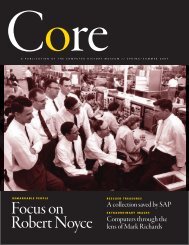HOW EUROPE MISSED THE TRANSISTOR - PBS
HOW EUROPE MISSED THE TRANSISTOR - PBS
HOW EUROPE MISSED THE TRANSISTOR - PBS
- No tags were found...
You also want an ePaper? Increase the reach of your titles
YUMPU automatically turns print PDFs into web optimized ePapers that Google loves.
+HISTORYINVENTION AND INVENTORS: In Paris,shortly after World War II, two Germanscientists, Herbert Mataré [left] andHeinrich Welker, invented the “transistron,”a solid-state amplifier remarkablysimilar to the transistor developedby Bell Telephone Laboratories at aboutthe same time. In this X-ray image ofa commercial transistron built in theearly 1950s, two closely spaced metalpoint contacts, one from each end, touchthe surface of a germanium sliver. A thirdelectrode contacts the other side of thesliver. Mataré is now retired and livingin Malibu, Calif.<strong>HOW</strong> <strong>EUROPE</strong><strong>MISSED</strong> <strong>THE</strong><strong>TRANSISTOR</strong>The most important invention of the 20th centurywas conceived not just once, but twiceBY MICHAEL RIORDANwww.spectrum.ieee.org November 2005 | IEEE Spectrum | INT 47
HerbertMataré,1946<strong>TRANSISTOR</strong> TWIN: The cross-sectiondrawing [right] from the French magazineToute la Radio depicts the insideof a commercial Westinghouse transistron[above center]. In the drawing,the two metal points (chercheurs) contactthe surface of a germanium sliver(cristal). A technician adjusted thepositions of the two contacts to givethe proper electrical characteristicswhile viewing them through a window(fenêtre). The internal structure issimilar to Bell Labs’ first prototypepoint-contact transistor [far right],produced in 1948.shortly after Bell TelephoneIN LATE 1948, Laboratories had announcedthe invention of the transistor, surprising reports began comingin from Europe. Two physicists from the German radar program,Herbert Mataré and Heinrich Welker, claimed to have inventeda strikingly similar semiconductor device, which they called thetransistron, while working at a Westinghouse subsidiary in Paris.The resemblance between the two awkward contraptions wasuncanny. In fact, they were almost identical! Just like the revolutionaryBell Labs device, dubbed the point-contact transistor,the transistron featured two closely spaced metal points pokinginto the surface of a narrow germanium sliver. The news fromParis was particularly troubling at Bell Labs, for its initial attemptsto manufacture such a delicate gizmo were then running intosevere difficulties with noise, stability, and uniformity.So in May 1949, Bell Labs researcher Alan Holden made a sortieto Paris while visiting England, to snoop around the city andsee the purported invention for himself. “This business of theFrench transistors would be hard to unravel, i.e., whether theydeveloped them independently,” he confided in a 14 May letterto William B. Shockley, leader of the Bell Labs solid-state physicsgroup. “As we arrived, they were transmitting to a little portableradio receiver outdoors from a transmitter indoors, which theysaid was modulated by a transistor.”Four days later, France’s Secretary of Postes, Télégraphes etTéléphones (PTT), the ministry funding Mataré and Welker’sresearch, announced the invention of the transistron to the Frenchpress, lauding the pair’s achievement as a “brilliante réalisationde la recherche française.” Only four years after World War II hadended in Europe, a shining technological phoenix had miraculouslyHeinrichWelker,1970GETTING TO <strong>THE</strong> POINT: After JohnBardeen and Walter Brattain inventedthe point-contact transistor inDecember 1947, Bell TelephoneLaboratories quickly began producingits Type A transistor. In the pictureabove, two metal points, called theemitter and the collector, contactthe surface of a germanium sliver,which has a third contact knownas the base attached to its back side.risen from the still-smoldering ashes of the devastation.“This PTT bunch in Paris seems very good to me,” Holden candidlyadmitted in his letter. “They have little groups in all sorts ofrat holes, farm houses, cheese factories, and jails in the Paris suburbs.They are all young and eager.” And one of these small, aggressiveresearch groups, holed up in a converted house in the nearbyvillage of Aulnay-sous-Bois, had apparently come through spectacularlywith what might well be the invention of the century—a semiconducting device that would spawn a massive new globalindustry of incalculable value. Or had it?As was true for the Bell Labs transistor, invented byJohn Bardeen and Walter H. Brattain in December 1947, the technologythat led to the transistron emerged from wartime researchon semiconductor materials, which were sorely needed in radarreceivers. In the European case, it was the German radar programthat spawned the invention. Both Mataré and Welker playedcrucial roles in this crash R&D program, working at different endsof the war-torn country.Mataré [see photo in “Transistor Twin”], who shared his remembrancesfrom his home in Malibu, Calif., joined the German researcheffort in September 1939, just as Hitler’s mighty army rumbled acrossPoland. Having received the equivalent of a master’s degree in appliedphysics from Aachen Technical University, he began doing radarresearch at Telefunken AG’s labs in Berlin. There he developed techniquesto suppress noise in superheterodyne mixers, which convertthe high-frequency radar signals rebounding from radar targets intolower-frequency signals that can be manipulated more easily in electroniccircuits. Based on this research, published in 1942, Mataréearned his doctorate from the Technical University of Berlin.48 IEEE Spectrum | November 2005 | INT www.spectrum.ieee.orgPRECEDING PAGES: LEFT: DEVICE COURTESY DR. ANDREW WYLIE, PHOTO: GUSTO IMAGES; RIGHT: ANDREAS TEICHMANNTHIS PAGE, CLOCKWISE FROM LEFT: HERBERT MATARÉ; DR. ANDREW WYLIE; SIEMENS AG; MICHAEL RIORDAN/BELL LABS; ARMAND VAN DORMAELAt the time, German radar systems operated at wavelengths asshort as half a meter. But the systems could not work at shorterwavelengths, which would have been better able to discern smallertargets, like enemy aircraft. The problem was that the vacuumtubediodes that rectified current in the early radar receivers couldnot function at the high frequencies involved. Their dimensions—especially the gap between the diode’s anode and cathode—weretoo large to cope with ultrashort, high-frequency waves. As a possiblesubstitute, Mataré began experimenting on his own withsolid-state crystal rectifiers similar to the “cat’s-whisker” detectorshe had tinkered with as a teenager.During the 1920s, he built crystal radio sets to listen to classicalmusic on the radio waves then beginning to fill the ether. OfBelgian extraction, he was raised in Aachen, Germany, in a familyimmersed in music. At the heart of each of his radios was a tinychip of semiconductor material, such as galena (lead sulfide) or silicon,with a fragile wire jabbed gingerly into its surface. For reasonsnobody fully understood until the late 1930s, this detector rectifiedthe alternating-current signal from the antenna into the directcurrentsignal needed to drive headphones.Similar point-contact devices, especially those made with silicon,could be used as the rectifier required in the superheterodynemixer circuit of a radar receiver, which shifts the received frequenciesdown by mixing the input signal with the output of aninternal oscillator. Because the electrical action of such a crystalrectifier is confined to a very small, almost microscopic region onthe semiconductor surface, the device can rectify currents at relativelyhigh frequencies.Theoretical work by Walther Schottky at Siemens AG, in Munich,Germany, and by Nevill F. Mott at the University of Bristol, inEngland, had given Mataré and other radar researchers a much betterunderstanding of what was happening beneath the sharp metal point.When the point touched the semiconductor surface, excess electronsquickly flowed into it, leaving behind a neutral “barrier layer”less than a micrometer deep in the material just underneath it. Thisnarrow zone then acted like an asymmetric barrier to the furtherflow of electrons. They could jump the barrier much more readilyfrom the semiconductor surface to the metal point than vice versa,in effect restricting current flow to one direction.As the war ground on, the leaders of the Berlin-based Germanradar establishment urged the Luftwaffe to pursue research on systemsoperating at wavelengths well below 50 centimeters—in whatwe now call the microwave range. They argued that such systemswould be small enough to mount in warplanes and detect approachingenemy aircraft through dense clouds and fog.But German military leaders, basking smugly in their early victories,ignored those pleas. Luftwaffe chief Hermann Göring, whohad served as an open-cockpit fighter pilot in World War I,adamantly believed that the intrinsic fighting abilities of his Aryanwarriors made electronic systems superfluous. “My pilots,” hebragged, “do not need a cinema on board!”Everything changed after February 1943, however, when a BritishSterling bomber downed over Rotterdam in the Netherlands revealedhow far behind the Allies Germany had fallen in radar technology.Göring ordered a thorough analysis of the bomber’s 9-cm radar systemand recalled more than a thousand scientists, engineers, andtechnicians from the front in a desperate attempt to catch up. Bysummer they had built a working prototype, but it was much toolate. Allied bombers, aided by onboard radar systems that allowedpilots to operate even in foul weather, were pulverizing German citieswith increasing impunity.Mataré recalled the sudden urgency in an interview. He intensifiedhis previous R&D efforts on crystal rectifiers, particularlythose made of silicon, which seemed best suited for microwavereception. But the Allied bombing of Berlin was making life exceedinglydifficult for Telefunken researchers. “I spent many hours insubway stations during bomb attacks,” he wrote in an unpublishedmemoir. So in January 1944, the company shifted much of its radarresearch to Breslau in Silesia (now Wroclaw, Poland). Mataré workedin an old convent in nearby Leubus.Laboring full-time to get silicon rectifiers into production,Mataré had scant opportunity to work on reducing the oscillatornoise in radar receivers—an outgrowth of his doctoral dissertation.But he did manage to build and study an intriguing newdevice, the crystal “duodiode,” in which two closely spaced metalpoints contact the semiconductor surface, forming two adjacentcrystal rectifiers. If they possess the same resistance and capacitance,these two rectifiers can be used in a special circuit tocancel out noise from the oscillator of a superheterodyne mixer.The noise through one rectifier adds to the overall signal transmittedby the mixer, and the noise through the other rectifiersubtracts from that signal. But to ensure identical electrical characteristics,the points must be extremely close—far less than amillimeter apart—so that both contact the same tiny crystal grainon the surface of the semiconductor.Mataré worked with silicon samples provided by physicist KarlSeiler in Breslau and germanium samples from a Luftwaffe researchteam near Munich that included Welker, his future co-worker.Although silicon worked better for radar receivers because it rectifiedat higher frequencies, germanium duodiodes exhibitedintriguing behavior. When the two points touched the surface lessthan 100 micrometers apart, Mataré claims, he occasionally noticedthat by varying the voltage on one he could influence the currentthrough the other—a phenomenon he dubbed “interference.” Itseemed as if one of his points could affect a region extending farbeyond the narrow barrier layer predicted by Schottky’s theory.Mataré had stumbled upon a method to influence this layer,which had stubbornly blocked earlier attempts to make a solid-stateamplifier. But wartime urgencies kept him from pursuing thisintriguing possibility much further.Germany’s eastern front collapsed in January 1945, and the RussianArmy was swiftly approaching Breslau. The Telefunken lab in Leubuswas hastily abandoned, and all of Mataré’s lab books and records wereburned to keep them out of enemy hands. The group attempted toreconstitute its R&D program in central Germany, but the U.S. Armyterminated this effort when it swept through in April 1945, mercifullysending Mataré home to rejoin his family in nearby Kassel.Mataré’s future colleague Welker wasn’t spared the indignitiesof war, either. Allied bombs destroyed his laboratory nearMunich in October 1944. Early the following year, this theoreticalphysicist, who during the 1930s had worked on the quantum mechanicsof electrons in metals, began speculating about how to use siliconand germanium to fabricate a solid-state amplifier.These two elements were widely regarded as metals during the1930s, but their apparent metallic behavior was due largely tothe high level of impurities in the available samples. When foreignatoms of elements in the fifth column of the periodic table—arsenic and phosphorus, for example—become lodged in the tetrahedralcrystal structure of silicon or germanium, four of their fiveoutermost electrons form strong bonds with nearby atoms, butthe fifth is easily knocked away and can thus transfer currentthrough the crystal. The much-higher-purity silicon and germaniumthat researchers used to build radar systems during WorldWar II had far fewer of such current carriers and behaved morelike semiconductors than like metals.www.spectrum.ieee.org November 2005 | IEEE Spectrum | INT 49
In early 1945, Welker, who was mastering the art of purifying germanium,recognized that the two semiconductors could be used tomake what we now call a field-effect transistor. In fact, the devicehe had in mind was strikingly similar to one that Shockley was tosuggest at Bell Labs a few months later.In this scheme, an electric field from a metal plate should penetrateinto a thin surface layer of a semiconductor strip beneath it,ripping electrons loose from their parent atoms to serve as currentcarriers. A voltage applied across the semiconductor strip wouldinduce a current through it. Crucially, a varying voltage on the metalplate would modulate the current through the strip. Thus, smallinput signals would result in large output currents flowing throughthe strip. Or so Welker figured.But tests he performed in March 1945 revealed no such amplification.In his logbook he recorded “only small effects,” orders ofmagnitude less than what was predicted by Schottky’s theory.Shockley, Brattain, and their Bell Labs colleagues attempted similartests that very same spring, with similarly disappointing results.The failures soon led Bardeen to postulate a novel idea of “surfacestates”—that free electrons were somehow huddling on the semiconductorsurface, shielding out the field. This conjecture, andBrattain’s follow-up experiments to determine the physical natureof the surface states, led to their invention of the point-contacttransistor in December 1947—a month after they discovered how toovercome the shielding.After his failures, Welker returned to research on germaniumand resumed the theoretical studies of superconductivity he hadreluctantly abandoned during the war. In 1946, British and Frenchintelligence agents interrogated him about his involvement inGerman radar. They subsequently offered him an opportunity towork in Paris in an R&D operation set up under the auspices of aWestinghouse subsidiary, Compagnie des Freins et Signaux Westinghouse.The immediate goal was to manufacture germanium rectifiersfor telecommunications and military electronics.While teaching in Aachen at his alma mater in 1946, Mataréwas also interviewed by agents. Fluent in French, he received a similaroffer. He eagerly agreed to join the Paris effort, because doingresearch in devastated, occupied Germany was almost impossible.Then in their mid-thirties, the two German physicists metin Paris and began organizing their operation. They found a vacanttwo-story stone house in the middle-class suburb of Aulnay-sous-Bois, just northwest of the city. In its basement, Welker set up hisequipment to purify and crystallize germanium. Mataré’s testingand measurements laboratory went on the ground floor, where laterthat year a production line began fabricating what soon amountedto thousands of rectifiers per month.On the top floor the men kept offices and rooms where they oftenstayed overnight—especially during that frantic first year. Mataréwistfully remembers awakening now and then to the soft trills ofWelker playing his violin in the adjoining room.With the rectifiers finally in production by late 1947, Welkerresumed his research on superconductivity, while Mataré began toaddress the curious interference effects he had seen in germaniumduodiodes during the war. When he put the two point contactsless than 100 µm apart, he again occasionally could get one of themto influence the other. With a positive voltage on one point, infact, he could modulate and even amplify the electrical signal atthe other! Mataré reckons he first recognized this effect in early1948 (perhaps a month or two after Bardeen and Brattain’s breakthroughat Bell Labs). But it still happened only sporadically.On a hunch, he asked Welker to fashion larger germanium samples,from which they could cut slivers of higher purity. Using thisTUNING IN: At theDüsseldorf Radio Fair in1953, the German firmIntermetall unveiled whatwas probably the world’sfirst transistor radio, morethan a year before TexasInstruments claimed thatmilestone. The radio’samplifier circuit was builtaround four point-contacttransistors made byIntermetall, whichHerbert Mataréand businessmanJakob Michael hadfounded in 1952.higher-grade material, Mataré finally got consistent amplificationin June 1948, six months after Bardeen and Brattain. Encouragedby this success, they phoned PTT Secretary Eugène Thomas andinvited him over for a demonstration. But Thomas was apparentlytoo busy—or perhaps not interested enough—to come by.About that time, Welker put aside his theoretical work and triedto analyze what was going on just beneath the shiny germaniumsurface of Mataré’s odd contraption. In an undated, handwrittendocument, now in the archives of Munich’s Deutsches Museum,Welker speculated that one point—which he called the “électrodede commande,” or “control electrode”—was inducing strong electricfields in the germanium just beneath the other electrode, alteringthe material’s conductivity there.But Mataré was not buying that explanation, which followed thelogic of Welker’s unsuccessful 1945 attempt at a semiconductor amplifier.If the phenomenon were caused by an electric field, Mataréremembers thinking, he should have witnessed a decrease in the currentat the second electrode, not the increase he observed on hisoscilloscope. According to this field-effect idea, a positive potentialon the control electrode would induce negative charges in thegermanium under the other electrode, which should reinforce thecurrent-blocking effects of the barrier layer there.Mataré argued instead that the control electrode must be injectingpositive charges, called holes, into the germanium. And perhapsby trickling along the boundary between two crystal grains,he guessed, they reached the other electrode—many micrometersdistant. There they would bolster the conductivity under this electrodeand enhance the current through it. “Welker didn’t reallyunderstand my measurements,” Mataré says. “At the time he wastoo busy studying superconductivity.”But as the two men were debating the merits of their competinginterpretations, surprising news arrived from across the Atlantic.In a 30 June press conference, Bell Labs suddenly lifted its six-monthveil of secrecy and announced the invention of the transistor byBardeen, Brattain, and Shockley. The breakthrough was reportedin The New York Times on 1 July and published in the 15 July issueof Physical Review. Incredibly, the Bell Labs solid-state amplifier alsohad a pair of closely spaced metal points prodding into a germaniumsurface. [See photo, “Getting to the Point.”]Mataré soon learned Bardeen and Brattain’s explanation of thecurious effects he had been observing. Electrons trapped on the germaniumsurface induce a shallow, positively charged layer justbeneath it. Holes emitted by the control electrode (which they hadHERBERT MATARÉ/INTERMETALLdubbed the “emitter”) travel easily within this layer over to the outputelectrode (or “collector”), markedly boosting the conductivitybeneath it and therefore the current flowing through it.After the Bell Labs revelations, Mataré and Welker had little difficultygetting the PTT minister to visit their lab. Thomas urgedthem to apply for a French patent on their semiconductor triode; healso suggested they call it by a slightly different name: transistron.So the two physicists hastily wrote up a patent disclosure and passedit on to the Westinghouse lawyers.On 13 August, the company submitted a patent application fora “Nouveau système cristallin à plusieurs électrodes réalisant des effetsde [sic] relais électroniques” to the Ministry of Industry and Commerce.Its brief description of what might be happening inside thegermanium mostly followed Welker’s field-effect interpretation butwas probably influenced by Bardeen and Brattain’s explanations.By the May 1949 press conference, the two Germans had thedevice [see X-ray image in “Invention and Inventors”] in limitedproduction and were beginning to ship units for use by the PTT asamplifiers in the telephone system—initially in the line betweenParis and Limoges. Speaking to the Paris press, Thomas comparedthese devices with vacuum tubes and demonstrated their use inradio receivers. Reporters hailed the two physicists as “les pères dutransistron” (the fathers of the transistron). The French device “turnsout…to be superior to its American counterpart,” read a more measuredbut still favorable account in Toute la Radio, a technical journal[see drawing and photo in “Transistor Twin”]. “The latter hasa limited lifetime and appears to be fairly unstable, whereas theexisting transistrons do not show any sign of fatigue.”According to Mataré, this superiority could be attributed tothe care they employed in fabricating their devices. While observingthe process with microscopes, the women working on thesmall assembly line would measure current-voltage curves forboth metal points with oscilloscopes and fix the points rigidly onthe germanium with drops of epoxy after the curves matched thedesired characteristics. When Brattain and Shockley visited theParis group in 1950, Mataré showed them telephone amplifiersmade with his transistrons—which allowed him to place a callall the way to Algiers. “That’s quite something,” admitted Shockleya bit guardedly, Mataré recalls half a century later.But the French government and Westinghouse failedto capitalize on the technical advantages in semiconductors thatthey then appeared to have. After Hiroshima, nuclear physics hademerged as the dominant scientific discipline in the public mind,and nuclear power was widely heralded as the wave of the future.France became enchanted with pursuing the nuclear genie unbottledin the 1940s, while ignorant of its promising transistron.Mataré and Welker struggled on in Paris for two more years, butas support for their operation waned during the early 1950s, theystarted looking for jobs in their native land. In 1951 Welker accepteda post at Siemens in Erlangen, Germany, where he pioneered earlyresearch on III-V compound semiconductors, such as galliumarsenide. In the late 1950s and early 1960s, those materials fostereda small optoelectronics revolution in semiconductor lasers and lightemittingdiodes. Welker became head of all R&D projects at Siemensin 1969 and retired in 1977. He died in 1981.In 1952, with solid funding from a wealthy German businessman,Jakob Michael, Mataré moved to Düsseldorf, Germany, andfounded a company called Intermetall. It began manufacturing germaniumrectifiers and transistors similar to the point-contact deviceshe had made in Paris. The company bought or built equipment thathelped it produce semiconductor devices of even higher quality.The summit of Intermetall’s achievements came at the 1953Düsseldorf Radio Fair. There a young, dark-haired woman demonstratedwhat was probably the world’s first transistor radio, builtaround four Intermetall point-contact transistors [see photo,“Tuning In”] more than a year before Texas Instruments Inc., inDallas, publicly claimed that milestone for itself.But after Michael sold the firm to Clevite Corp., then inCleveland, later that year, its focus shifted almost exclusively to productionand away from research. Discouraged by that about-face,Mataré left Germany and immigrated to the United States, wherehe found work in the U.S. semiconductor industry. Even today, at 93,the IEEE Life Fellow remains active, consulting from his Malibu homeon such projects as a large, innovative photovoltaic array built inSouthern California [see The Back Story, in this issue].What is arguably the most important invention of the20th century remarkably occurred twice—and independently. Giventhe secrecy shrouding the Bell Labs device, there is no possibilityMataré and Welker could have been influenced by knowledge of itbefore July 1948, when news of the revolutionary invention becamewidespread. And it seems clear from the still-sketchy historical recordthat they indeed had a working, reliable amplifier by that time.This dual, nearly simultaneous breakthrough can be attributedin part to the tremendous wartime advances in purifying silicon and,in particular, germanium. In both cases, germanium played the crucialgateway role, for in the immediate postwar years it could berefined much more easily and with substantially higher purities thansilicon. Such high-purity semiconductor material was absolutelyessential for fabricating the first transistors.But the Bell Labs team had clear priority—and a superior physicalunderstanding of how the electrons and holes were flowinginside germanium. That advantage proved critical to subsequentachievements, such as Shockley’s junction transistor [see “The LostHistory of the Transistor,” IEEE Spectrum, May 2004], which wasmuch easier to mass-produce with high reliability and uniformity.By the mid-1950s, nobody was trying to make point-contact transistorsany longer, and the industry was moving on to silicon.A factor crucial to success in the nascent semiconductor industrywas the sustained innovation that flourished at Bell Labs—aswell as at Texas Instruments and Fairchild Semiconductor—leadingto silicon transistors and integrated circuits. And that requiredextensive infrastructure, both material and intellectual, to keep thesecompanies at the frontiers of this fast-moving field. Such an infrastructurealready existed in the United States after World War IIbecause of its wartime radar efforts. But France had no comparableinfrastructure and had to import talent from occupied Germany,which could not exploit its own radar expertise until the 1950s.In the absence of any such advantages, it was inevitable thatEurope’s fledgling transistor would soon be eclipsed by other, bettersemiconductor devices and eventually fade from memory. ■ABOUT <strong>THE</strong> AUTHORMICHAEL RIORDAN teaches the history of physics at StanfordUniversity, in California, and the University of California, SantaCruz. He is coauthor of Crystal Fire: The Birth of the InformationAge.TO PROBE FUR<strong>THE</strong>RFor more details on the invention of the transistron, see “The‘French’ Transistor,” by Armand Van Dormael, in Proceedings ofthe 2004 IEEE Conference on the History of Electronics,Bletchley Park, England, June 2004. It is available on the Webat http://www.ieee.org/organizations/history_center/Che2004/VanDormael.pdf.50 IEEE Spectrum | November 2005 | INT www.spectrum.ieee.orgwww.spectrum.ieee.org November 2005 | IEEE Spectrum | INT 51



